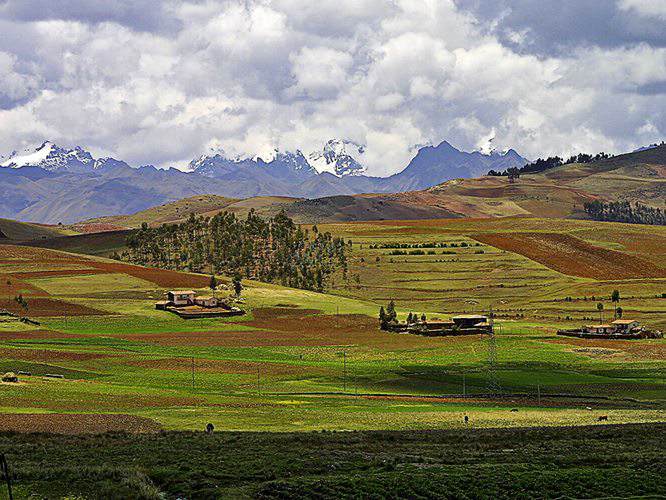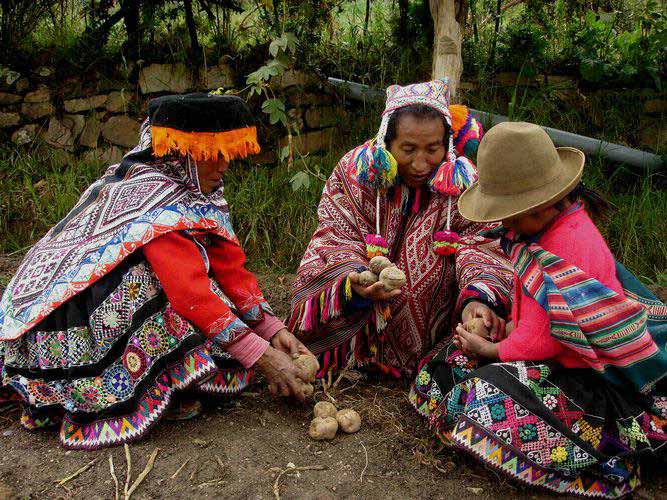
Through a confluence of organic and man-made features, the Sacred Valley has become a center for plant cultivation with a fundamental role in both Peruvian and world agriculture. Nature had endowed this valley with fertile soils and an abundant water supply. Agriculturalists have taken advantage of these assets to create one of the largest reserves of horticultural diversity in the Andes and around the globe.
Travel Guide: Sacred Valley
 Plots of agricultural fertility.
Plots of agricultural fertility.
Photo by Alfredo Miguel Romero/Flickr
The multiple altitudinal layers that comprise the Sacred Valley create a wide set of microenvironments. On top of this natural advantage, the Inca built an infrastructure of agrarian terraces that further multiplied the number of microclimates and ecological niches suitable for growing. In the present-day, these ancient terraces are planted with endemic highland flowers, a wide variety of cereals (including quinoa), hundreds of vegetables, and an enormous variety of potatoes – specialists have counted around 4,000 species of spuds apt for human consumption. At a time when issues of food security are becoming increasingly important, it is the hope of the Peruvian government and local populations that the Sacred Valley will remain free of transgenic crops and continue to serve as an agricultural breadbasket for the globe.
 Locals tending to their crops in the Sacred Valley.
Locals tending to their crops in the Sacred Valley.
Photo by Michael McDonough/Flickr
Community-based ecotourism provides visitors the chance to experience firsthand the Sacred Valley’s biodiversity and its social correlate. A few community associations in the valley, such as Los Yachaqs, have created programs that introduce travelers to their daily activities including planting, harvesting, and cooking with crops as well as animal husbandry and textile-weaving. These programs offer tremendous opportunities for visitors to become involved in responsible travel projects.
Sacred Valley Tours:
Potato Park, or Parque de la Papa, is a creative project devoted to the protection of potato species diversity. The 9,000-hectare park is located in the middle of the Sacred Valley and is administered by the Association of Communities of Potato Park, comprised of five Quechua villages – Sacaca, Chawaytire, Pampallaqta, Paru-Paru, and Amaru. Within the realm of the park, traditional knowledge merges with modern technology to preserve the biocultural heritage of indigenous potatoes and other ancestral crops. The Andean principles of balance, reciprocity, and duality infuse the activities of partnering communities.
 Community workers at Parque de la Papa work toward the preservation of potato diversity.
Community workers at Parque de la Papa work toward the preservation of potato diversity.
Photo by iied/Flickr
The park promotes economic innovations as well as community sustainability projects based on values of social justice, mutual support, and respect for the environment. Additionally, the park offers trekking tours and a cooking workshop at the communal restaurant, Papamanka, where you can have a taste of the breathtaking biodiversity that is being protected. Finally, the Park also collaborates with national and international efforts, mostly channeled through the International Center of the Potato (CIP) in Lima and the International Forum for the Diversity of Crops, to supply seeds and crops to projects like the Svalbard Crop Seed Vault.
Peru For Less offers a variety of fully customizable tours. Talk with an expert travel advisor now to start planning your dream trip!
LEARN MORE about this region of Peru. Checkout our complete Cusco and Sacred Valley Travel Guides online! It’s free and filled with helpful, up-to-date information.



Email: [email protected]
Sign up to receive our newsletter for great articles, stunning photos, and special deals.